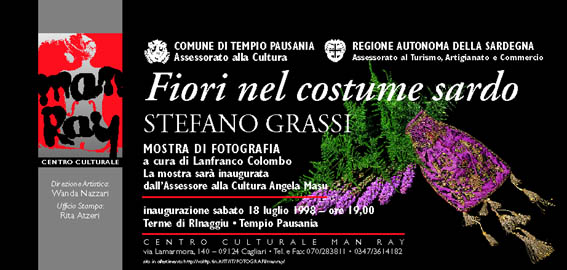

Flowers in Sardinian Costumes
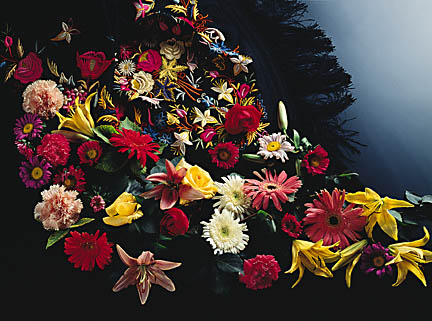
I have known Stefano Grassi for quite some time and I still have not succeeded in deciding whether I prefer his coherent photographic research or his ability as an organiser of cultural events. My impression is that his lively individual commitment to creative art is insufficient to satisfy the inner urgency that moves him, and that he finds it almost a necessity to animate such events: to stimulate, to bring together keen minds, to promote comparisons and catalyse moments of growth, which is what Grassi does through the Centro Man Ray, a cultural association among the most active in Cagliari, thanks to his commitment, that of his mother, the artist Wanda Nazzari, and others.
 Active for many years in photographic research, Stefano
Grassi is now a poetic investigator of form and poetry and now an acute
observer of the reality surrounding him. At other times I have admired his
rarefied investigations into the nude.
Active for many years in photographic research, Stefano
Grassi is now a poetic investigator of form and poetry and now an acute
observer of the reality surrounding him. At other times I have admired his
rarefied investigations into the nude.
Here he presents a series of still-lifes entitled "Fiori nel costume sardo" (Flowers in Sardinian Costumes) where Grassi, in his meticulous research, documents the preciousness of the embroidery in the costumes of his native land, Sardinia, the traditions of which the author is not only a sensitive observer, but also acutely and profoundly knowledgeable.
 If it is true that "you photograph what you know",
the consequential axiom that the better you know something the better you
should be able to "photograph" it should be even truer, where
the verb must be intended in its fullest meaning and interpretation.
If it is true that "you photograph what you know",
the consequential axiom that the better you know something the better you
should be able to "photograph" it should be even truer, where
the verb must be intended in its fullest meaning and interpretation.
These beautiful photos by Stefano Grassi are extremely significant: each of them has a long story to tell, and I would have liked the author to stay and tell it to those who are observing them.
 In the obvious impossibility of such an idea, I believe
it is enough to abandon oneself to the narrative fascination of the photos,
in which the photographer has succeeded in condensing the salient features
of a civilisation and a culture, and let oneself be guided by them along
an itinerary leading to discovery and reflection.
In the obvious impossibility of such an idea, I believe
it is enough to abandon oneself to the narrative fascination of the photos,
in which the photographer has succeeded in condensing the salient features
of a civilisation and a culture, and let oneself be guided by them along
an itinerary leading to discovery and reflection.
Lanfranco Colombo
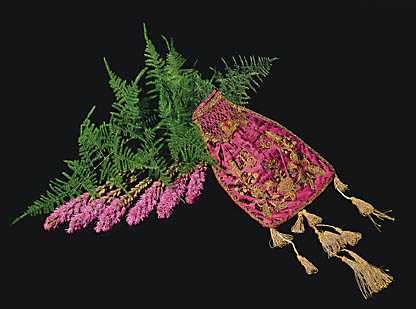
Embroidered costumes bloom with the same flowers as the bouquets of fresh flowers placed beside them, and compete with them in beauty and colour. Stefano Grassi portrays the materials of Sardinian tradition in their chromatic preciousness, together with the shapes and colours of the flowers that inspired the embroidery of archaic origin. These are images showing a taste for the pictorial in which the search for the dyes and the almost philological choice of the floreal element come together into a single visual feast.
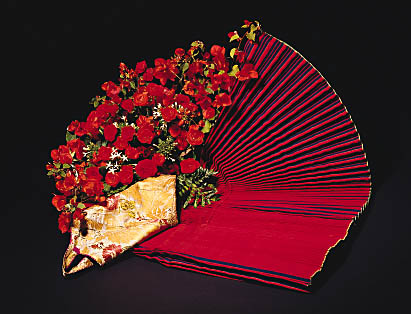
Uninhabited costumes appear in the photos; neither faces nor jewels are there to distract the eye from the closeups of shawls, bodices and bonnets standing out brightly in their intimate dialogue with the flowers. The roses, the sprigs of wheat and every other essence chosen with the utmost care spring from the designs and at the same time hide within them, in a continuous game of changing places and mutual recognition. The identification is total and constant in the use of space in the background, rendered empty, solitary, cancelled by the liveliness of the composition, a still-life of refined austerity. The female clothing, pleated, embellished, woven with timeless skill, are folded in ways that are uncommon on this new occasion for coquettishness: they become fans, drapes, spokes of a wheel, sculptures forged on the loom to celebrate a singular encounter. Vegetable dyes, those of tradition, are the base on which are laid the gold and silk of feast days and auspiciousness. Entwined with them are the regal bouquets, with the same tones, the ones reflecting the others, giving the impression of mirrored images.
Alessandra Menesini
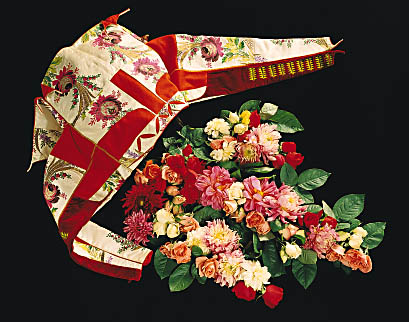
Stefano Grassi. He was born in Cagliari in 1960. As a professional photographer, in 1985 he founded the Studio di Comunicazione Visiva PhotArt (the Studio is an advertising agency specializing in the creation of company images, graphic projects for the publishing industry, advertising and TV commercials). In 1988, he specialized in advertising photography at the Istituto Europeo di Design, presenting a dissertation on animated advertising photography (stage photography). Since 1988 he has been teaching photography: (Compagnia d'Arte Laterale, I.E.D., Man Ray Cultural Centre, in vocational training courses). In 1995, he founded the Man Ray Cultural Centre in Cagliari, Italy, of which he is the president and coordinator of teaching activities.
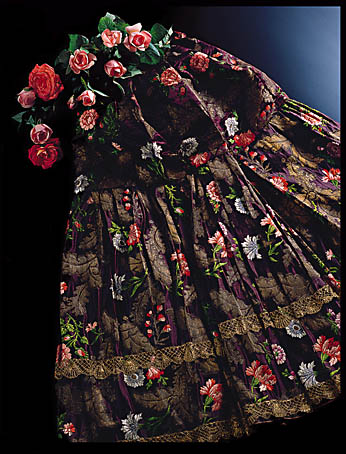
Among his most important exhibitions are: 1987, "IV Art Co-opera Plexus International Art Slaves", Gavoi (Nuoro, Italy); 1988, "Collettiva Galleria Duchamp" (advertising photography), Cagliari; 1990, "The Flower in Sardinian Weaving and Embroidery", Italia 90, Cagliari; 1991, "Photography in Cagliari. From Photo Journalism to the New Trends", Municipal Art Gallery, Cagliari; 1992, "International Exhibition WCCP", Orlando, Florida, USA; 1992 "The Breath of the Eye", Istituto Europeo di Design, Cagliari; 1993, "Origin", International Photography Exhibition, Passeggiata Coperta Bastione San Remy, Cagliari; 1996, "Five Photographers for an Island", Man Ray Cultural Centre, Cagliari; 1996, "Five Photographers for an Island", Bellinzona, Switzerland; 1997, "Becoming Nude" Mostra Internazionale di Fotografia Pass. Coperta Bastione St.Remy, Cagliari; 1998 "Becoming Nude", Quartu S.E.; 1998 "Fiori nel costume sardo" Spazio Giovenzana, Milano.
Permanent works: Galleria Comunale d'Arte di Cagliari; Credito Industriale Sardo, Cagliari; Istituto Europeo di Design, Cagliari; Galleria WCCP, Orlando, Florida (USA); Centro Culturale Man Ray, Cagliari.
The critics have written: Giovanna Caltagirone, Martino Casalini, Lanfranco Colombo, Alessandra Menesini, Salvatore Naitza, Maria Spissu Nilson, Daniela Paba, Giorgio Pellegrini, Mauro Rombi.

English translation: David Nilson